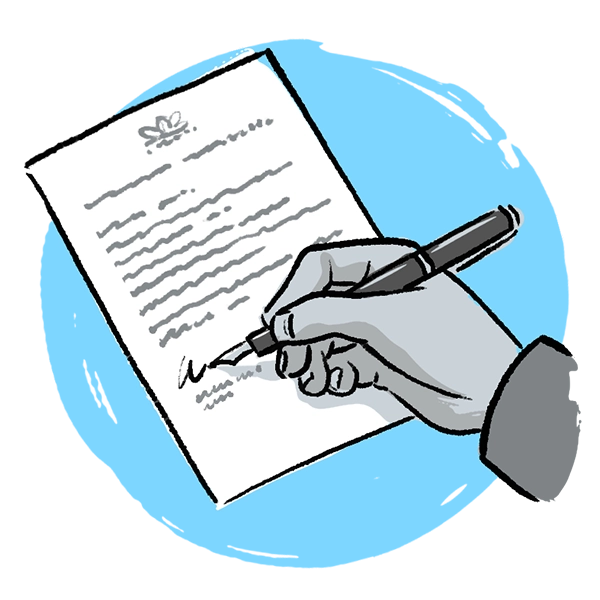Interest in possession trust (Life Interest trust)
This type of trust entitles the beneficiary (in this case referred to as the Life Tenant”) to the net income from the trust, but they don’t have a right to the underlying cash, property or investments that generate that income (i.e. the capital). It is commonly used to ensure that a dependant such as a spouse receives an income for life, or is able to live in a property. The role of the trustees is to manage the assets on a day-to-day basis, including making investment decisions, and pay the income generated, minus any expenses incurred, to the beneficiary.
On the death of the life tenant, the assets will then pass per the terms of the trust to the ‘final’ beneficiary who is entitled to the asset itself (e.g. to the settlor’s children or a discretionary trust).
Read our case study
Life interest Trust FAQ’s
The technical name for a Life Interest Trust is called an Interest in Possession Trust. These trusts are designed to protect assets such as property, savings and possessions against re-marriage or the long-term effects of care fees. They allow the person making the trust to ringfence assets for the benefit of someone for their lifetime (called the Life Tenant) and then to transfer them to chosen beneficiaries after the Life Tenant has died, or other conditions have been met such as a remarriage.
The Life Interest Trust protects your assets (whether that is a share of the family home, or an amount of cash savings) for your chosen beneficiaries (i.e. your children), whilst allowing your surviving partner to remain living in the family home for the rest of their life, or for as long as they wish to. If you have left cash assets in the trust then your surviving partner will be entitled to the income generated from that. If the survivor doesn’t want to stay in the family home, then it can be sold, and the money will be invested with the income being paid to them. Alternatively, they might decide to rent the property and they will be entitled to the rental income. The capital from your share of the family home will still be protected for your chosen beneficiaries.
No. Most couples who own the family home jointly will own it as joint tenants. This means that when one of the co-owners dies, the property will pass automatically to the surviving co-owner, regardless of what your Will says.
If this happens then the family home will become 100% theirs and they can dispose of it as they wish.
This could be problematic if they need long-term care, or if they remarry. This is because your share of the family home could be used to pay for that care or become an asset of the new marriage, and therefore not be available to your chosen beneficiaries.
To protect your share of the family home, you will need to own it as tenants in common and include a Life Interest Trust in your Will. Holding the family home as tenants in common means that you and your partner own distinct shares of the family home which pass under the terms of your respective Wills.
When you prepare your Will, you are able to include a Life Interest trust in it. When you pass away, the assets that you have selected to pass into the trust will be transferred to your Trustees to look after on behalf of your beneficiaries.
This is fine. If you sell your current home and buy a new family home (owned as tenants in common) then the terms of the Life Interest can apply to this new home.
If you sell the home and then don’t buy a new one (for example if you decide to rent) then the Life Interest Trust will not apply over the property. You may want to include a Life Interest trust over cash assets as well to take this into account and ensure that a certain amount of money is passed into the trust.
Yes, the Life Interest Trust can be drafted in such a way as to enable the survivor to request that the Trustees sell the family home and buy a new property, which will be held on the same terms.
If the property is cheaper, then any surplus cash will be invested to provide an income for the survivor, whilst the capital is still protected for your chosen beneficiaries.
Whilst the survivor is living in the Family Home, he or she will be responsible for the outgoings i.e. the bills, and for any repairs. They must keep the property in good condition and make sure that it is fully insured.
Whilst you can do this, it is something that must be given very careful consideration as there are not only potential inheritance tax consequences, but there is the risk of losing your home if your children become bankrupt, get divorced or die. The use of a Life Interest trust protects against all of these issues and gives you more peace of mind.
HMRC require Life Interest Trusts to be registered on their Trust Registration Service. Your trustees will be responsible for doing this after you die. There is no other formal administration involved during the lifetime of the trust.
When the survivor of you dies then the Trustees can arrange to transfer the house (or the cash assets) to the remaining beneficiaries.
Life interest trusts are usually set up in your will. It is recommended that you ask an SRA regulated firm or solicitor to set it up for you. We do not advise that you try and do it yourself as there can be tax consequences if the drafting is incorrect.
This is a form of life interest trust where you can specify that the life tenant can be advanced capital from the assets held in trust, if that is something that you would like to happen. Many people want to protect assets from the possibility of sideways disinheritance (surviving spouse re-marrying and effectively disinheriting their children from previous marriage/relationship) but they do not want their surviving spouse to struggle financially. Overriding powers can be given to your trustees to advance capital from the trust to the life tenant if they feel it is appropriate to do so.
Discretionary trust
A discretionary trust is a popular option for families aiming to protect their assets, given the high degree of flexibility they offer. The settlor hands the assets over to the trustees and will often give guidance as to how they would like them to be used. The trustees have complete discretion as to how both income and capital funds are to be distributed among the beneficiaries. What is worth noting is that no beneficiary of a discretionary trust has any legal entitlement to the assets; it is completely down to what the trustees decide. Because there is no legal entitlement, discretionary trusts are popular when settlors are trying to protect money as none of the funds can be taken into account for example in divorce proceedings, or benefits entitlement.
Discretionary trusts are particularly useful as a way of providing for children, as they enable the trustees to provide funds to each child as and when they are needed, such as to pay for their education, rather than equally and at the same time. Similarly, they can also be useful for providing for adult beneficiaries at key points in their life (for instance, buying a new home, setting up a new business, or financial hardship) while preserving a fund for future generations.
Read our case study
Discretionary Trust FAQ’s
A Discretionary Trust is a special type of Trust that gives the Trustees full discretion on how capital and income is distributed to beneficiaries. In most other forms of trusts, a beneficiary will typically have some rights to the trust assets – whether it be income, capital or both. A discretionary trust is completely different.
A Discretionary Trust is when the settlor (the person making the trust) puts assets into a trust and gives Trustees full control over when and how much funds are distributed to the beneficiaries. In turn, the beneficiaries have no rights to the funds held in the Trusts.
In most cases, Trusts are set up with specific terms that instruct the Trustee to distribute funds to beneficiaries on a set schedule. The terms also usually set how much should be distributed. Discretionary Trusts are unique from other types of Trusts because there are no such terms. It is up to the Trustee to decide if beneficiaries should receive any distributions, how much, and when.
Beneficiaries of a Discretionary Trust do not have any legal claims over the Trust funds. The Trustee has complete control and is considered the legal owner, although they cannot benefit from the funds in any way.
The key purpose of a Discretionary Trust is to provide maximum protection for the funds held in the Trust, and to the greater benefit of its beneficiary or beneficiaries. These Trusts are most useful when the Trustor feels that it is in the best interest of the beneficiaries. For instance, the beneficiary of a Discretionary Trust may have displayed continued irresponsible behaviour, is disabled, mentally impaired, has a gambling problem, has a great deal of debt or is at risk of undue influences (eg an abusive or controlling partner). The Trustees can help protect the beneficiaries from themselves, as well as the assets from creditors. It is under the Trustee’s discretion to determine when it is appropriate to provide funds to the beneficiary, and how much.
By giving the greatest amount of power to the Trustee, they can decide how and when beneficiaries should receive funds in such a way that would support them best. Let’s walk through some possible scenarios to illustrate when a Discretionary Trust may be used.
A discretionary trust allows an enormous amount of flexibility in how the assets are held and distributed. Because none of the beneficiaries have any entitlement to the trust assets then it is impossible for any part of the trust to be included in their estate. This is beneficial as it means that if any of the beneficiaries get divorced, become bankrupt or die then none of the trust assets are taken into account for those purposes. It is also a very beneficial arrangement if you have beneficiaries who are in receipt of state benefits as it will not affect their entitlement to them. The nature of the trust means that the Trustees can pay out income or capital to any of the beneficiaries as often as they feel appropriate, making it a very flexible way of looking after beneficiaries as their circumstances may change over the years.
Lack of control: The nature of a Discretionary Trust forces a Trustor to give up control. You can do what you can by creating guidelines and selecting a trustworthy Trustee, but after things are set in motion, you are no longer in control. This is especially so as Discretionary Trusts are irrevocable, meaning that you can’t change it or revoke it.
Complex: Trusts can already be somewhat complex to set up, and Discretionary Trusts are no different. Some may argue that setting up a solid Discretionary Trust structure can be even more tricky relative to other types of Trusts.
Trustee discretion: Last but not least, Trustee discretion can be a double-edged sword. On one hand, this discretion can be an important aspect of your strategy to protect the funds and your beneficiaries. On the other hand, giving your Trustee absolute discretion gives them the greatest amount of power. You should make absolutely sure that you can Trust your selected Trustee to carry out your wishes and not use the Trust for their own benefit.
A Discretionary Trust may continue for up to 125 years from the date of the testator's death. This was limited to 80 years in the case of wills signed on or before 5 April 2010. The testator will confirm how any undistributed assets remaining at the end of the trust period must be distributed when the trust comes to an end.
To understand who owns assets held in a Discretionary Trust is to also understand the distinction between legal ownership and beneficial ownership. In the case of a Discretionary Trust, the Trustee has legal control of the funds. Therefore, they are the legal owner. However, the funds are held and distributed to benefit the beneficiaries. The beneficiaries are the beneficial owners. The Trustee breaks the law if they use the funds that they own for their personal benefit and for any reason other than for the benefit of the beneficiaries.
Anyone can be appointed a Trustee of a Discretionary Trust. They are given the power to decide which beneficiaries should receive how much money, and when. They have the power to deny benefits from beneficiaries at any time. Further, the beneficiaries have no claim to the funds, meaning that they cannot try to force the Trustee to distribute funds.
The Trustees have a great deal of power and should be selected very carefully. They should be considered carefully and you must be satisfied that you can trust them to act in good faith. Many individuals like to consider their closest friends and family members as possible Trustees.
Yes, money can be taken out of a Discretionary Trust, but only in the hands of the Trustee. The Trustee has the discretion to decide when funds should be distributed out of the Trust, to whom, and how much. Beneficiaries of the Discretionary Trust cannot take money out of it themselves.
If the value of the trust does not exceed the Nil Rate Band (£325,000 at the time of writing) at the time the trust is implemented or at the time of any assessment, then there will be no tax to pay. There is also no Inheritance Tax to pay on the creation of the trust, nor on its termination when the sum settled is less than £325,000.
There are provisions for an exit charge on each distribution from the trust and a ten yearly charge once the trust has been in existence for that period. Upon every tenth anniversary the trust value in excess of the Nil Rate Band will be taxed at a maximum rate of 6% of its value. Distributions from the trust during the trust period will also be subject to a proportional charge if made in years between ten yearly anniversaries of the trust being created.
Making a Deed of Family Arrangement or Variation After Probate
A Deed of Variation or Family Arrangement enables the beneficiaries of a deceased’s estate to alter the distribution of that estate, and even to distribute the estate to a different beneficiary altogether. It is sometimes known as a deed of assignment, or deed of surrender or release and can be drawn up to two years after the date of death. In order to establish a Deed of Variation, ALL the beneficiaries of the Will must be in agreement. When children are involved, the matter is further complicated as they cannot themselves consent to changes. An application must be made to the courts for consent to be obtained on their behalf.
Why Use a Deed of Variation?
Reduce Tax Liability
The main use of a Deed of Variation is to re-write the distribution of the estate, so that is passes on in the most Inheritance Tax efficient way and to minimise post death Capital Gains Tax (CGT) liability.





